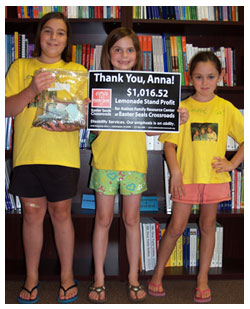Staff turnover rate at group homes
by Beth Finke
Our 23-year-old son lives in a group home. Gus is healthy and well taken care of. His life doesn’t change much, and stability is good for him. And for us, too.
When friends ask how Gus is doing, I give them my pat answer, tell them he’s fine. Really, the only thing we can imagine changing in Gus’ life from here on out is the staff at his group home. Working at a group home is such hard work, usually the turnover is high. “So at least there’s one good thing about the recession,” I say. “There aren’t many other jobs available, so for a long time now no one on staff has quit.”
Funny, the things we say sometimes without really knowing they’re true. I mean, I know the staff at the group home hasn’t turned over much the past two years. But is the turnover rate genearlly high in group homes? Or has that just been our experience where Gus lives?
Turns out hard statistics on this are difficult to come by. From a web site called SparkAction:
Though little studied and rarely acknowledged publicly, high staff turnover plagues the entire children and youth out-of-home care industry — and much of the developmental services field as well. The reasons vary from locale to locale, but experts in the field say the primary ones are: low pay, long hours, absence of career ladders and lack of pre-service and in-service training and skills to deal with sometimes difficult young people.
An article I found in the Salem Statesman Journal said the staff turnover rates in Oregon group homes average about 85 percent a year.
Studies in other states have found annual turnover rates ranging from 57 percent to more than 100 percent.
Unfortunately, the story did not quote a source for those numbers. The most definitive study I could find comes from Cheryl A. Larson, the co-author of a book called Staff Recruitment, Retention, & Training Strategies For Community Human Services Organizations. Larson’s dissertation looked at turnover in small group home settings and revealed an annual turnover rate of almost 50%. The SparkAction web site quotes Dr. Larson:
“Even more challenging, of direct support workers who left during the previous 12 months, 41 percent had left before finishing six months on the job, and another 25 percent left before finishing 12 months on the job,” she said.
So I guess it’s not just Gus’ group home that had always experienced a high turnover rate. I wonder, though, if the recession is having the same effect on other group homes that it seems to be having where Gus lives. Whatever the reason, we are grateful for the hardworking an dedicated staff there. A Godsend.







 An 8-year-old girl from Greenfield, IN put up a lemonade stand to sell drinks during her family garage sale last month and raised hundreds of dollars to donate to our
An 8-year-old girl from Greenfield, IN put up a lemonade stand to sell drinks during her family garage sale last month and raised hundreds of dollars to donate to our  When Harry Engnell Jr. graduated from high school in 1998, his parents found few supports available to help a young person with autism find work and make other transitions to adulthood.
When Harry Engnell Jr. graduated from high school in 1998, his parents found few supports available to help a young person with autism find work and make other transitions to adulthood.